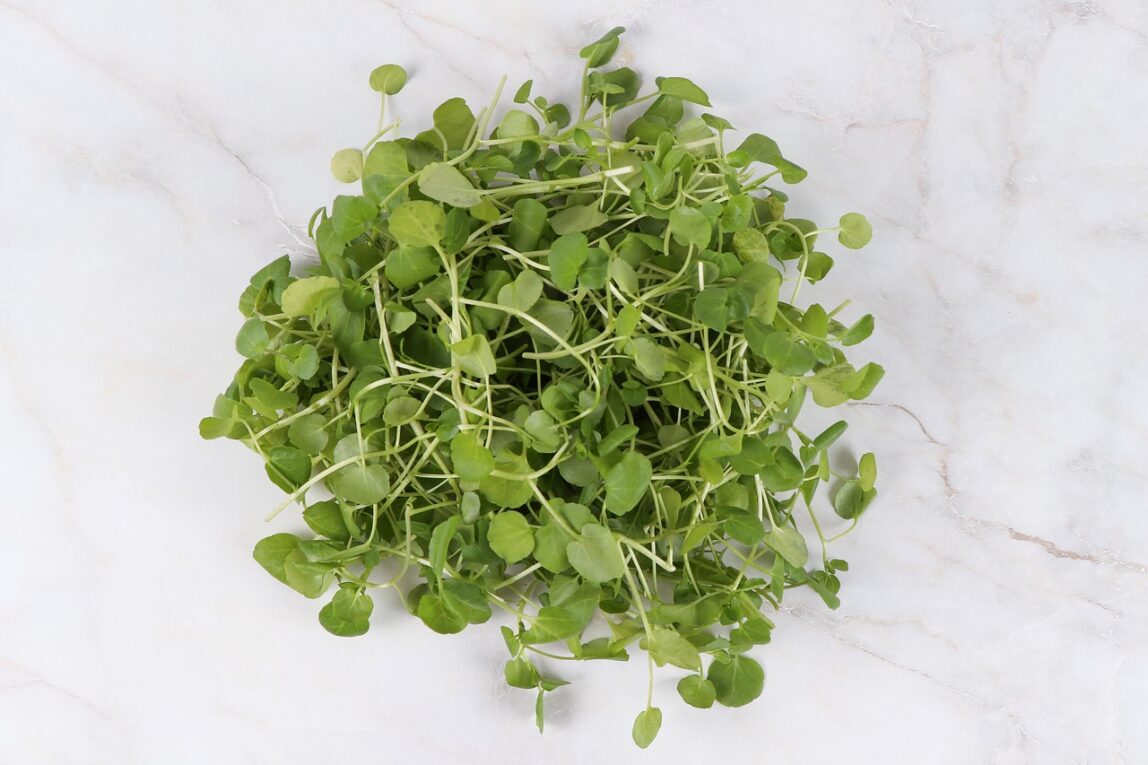Watercress (Nasturtium officinale) is a leafy green vegetable belonging to the Brassicaceae family, which includes other cruciferous vegetables like broccoli, kale and cabbage. It is native to Europe and Asia and is now cultivated worldwide for its culinary and medicinal properties.
Watercress Appearance
Watercress is a small, aquatic or semi-aquatic plant with tender, dark green leaves that grow in clusters along creeping stems. The leaves are small, round, and slightly peppery in flavor, similar to arugula or mustard greens.
Growth Habit of Watercress
Watercress typically grows in shallow, flowing water such as streams, springs or marshy areas. It thrives in cool, moist environments with plenty of sunlight. In cultivation, watercress is often grown hydroponically or in containers with a constant water supply.
History of Watercress Use
Watercress has a long history of its many medicinal uses, and a long history in general, dating back to the ancient times of the Greeks. It is a herb native to Europe but grown perennially all over the world. It is cultivated in water and often used in salads as greens.
Culinary Uses of Watercress
Watercress is prized for its crisp texture and peppery flavor, which adds a refreshing bite to salads, sandwiches, soups and stir-fries. It is commonly used as a garnish for various dishes and can also be blended into smoothies or juiced for its nutritional benefits.
Watercress is Full of Vitamins & Minerals
Watercress is a nutrient-dense vegetable rich in vitamins, minerals, antioxidants and phytochemicals, including:
Vitamin A
B Vitamins
Vitamin C
Vitamin D
Vitamin E
Vitamin K
Iron
Potassium
Calcium
Glycosides
Protein
Omega-3 Fats
Antioxidants
Leucine
Iodine
Fiber
Sulfur
Watercress is also low in calories and carbohydrates, making it a healthy addition to a balanced diet.
Health Benefits of Watercress
Watercress is a versatile and nutritious leafy green vegetable that can be enjoyed raw or cooked as part of a healthy diet. Its distinct flavor and abundance of nutrients make it a popular choice for culinary enthusiasts and health-conscious individuals alike.
Below we will explore some of the health benefits of Watercress in more detail:
Watercress for Skin Health
Watercress is a good source of lutein and beta-carotene, two important components in preventing UV-damage and maintaining skin health, which is key to an anti-ageing regime. It may also help in treating eczema, acne and generally problematic skin.
Antioxidants in Watercress
Watercress is heavy in antioxidants, a key ingredient in the prevention of cancer. The high antioxidant content of watercress helps neutralize harmful free radicals in the body, while its anti-inflammatory properties may help reduce inflammation and support overall health.
Antioxidants prevent damage to cells by stopping dangerous free radicals from running rampant and causing cancerous harm. These active antioxidants include; vitamin A, vitamin C, vitamin E and several B vitamins.
Watercress for Cancer Prevention
Watercress has potential cancer-preventive properties due to its high antioxidant content, anti-inflammatory effects and support for detoxification processes. Compounds like glucosinolates may inhibit tumor growth and angiogenesis. Additionally, watercress supports immune function and DNA protection.
The antioxidant properties of watercress especially help in preventing the damage to cells caused by smoking, thus potentially helping lower the cancer risk for lung and throat cancers.
While more research is needed, including watercress in a balanced diet may contribute to cancer prevention as part of a healthy lifestyle.
Watercress Keeps the Liver Healthy
Watercress is very rich in glucosinolates, which are water soluble phytochemicals that contain sulfur. The liver, which is the body’s filtration system, serves to clean the blood of impurities that pass through the body. It also controls synthesis, creates and breaks down proteins, and plays a key part in maintaining a healthy metabolism.
The liver is a vital organ that affects many systems, and watercress can help keep it healthy by regulating its enzymes.
Watercress for Weight Loss
A healthy digestive system is imperative to maintaining a healthy weight. Watercress is loaded with potassium, which acts as a diuretic and draws out excess water weight from the body.
Watercress has a lot of fiber, which treats and prevents constipation and other bowel troubles.
Watercress also contains iodine, which helps maintain a healthy thyroid gland, which in turn keeps the body’s metabolism healthy and active.
Watercress to Reduce Cholesterol
Including watercress in a balanced diet may help lower LDL cholesterol, reduce the risk of atherosclerosis and support overall cardiovascular health.
Watercress may help manage cholesterol levels due to its high fiber content, antioxidant properties and promotion of nitric oxide production. Its low saturated fat content and support for weight management further contribute to heart health.
Watercress to Improve Digestion
Watercress, a leafy green vegetable, may improve digestion through various mechanisms. Its high fiber content aids in bowel regularity, while natural enzymes assist in food breakdown.
Bitter compounds stimulate digestive juices, and its alkaline properties balance pH levels.
Watercress also possesses anti-inflammatory effects and prebiotic potential, promoting a healthy gut environment.
Incorporating watercress into a balanced diet may support overall digestive health, but individual responses may vary.
Watercress to Improve Immune Function
Watercress supports immune function through its rich content of immune-boosting nutrients like vitamin C and antioxidants. Its anti-inflammatory properties and phytonutrients further enhance immune response.
Additionally, watercress promotes gut health, which is crucial for overall immune function. Incorporating watercress into a balanced diet may strengthen the immune system and contribute to overall health.
Watercress for Diabetes
Watercress may be beneficial for individuals with diabetes due to its low glycemic index, high fiber content and nutrient density. Its anti-inflammatory effects and potential for weight management further support diabetes management.
Including watercress as part of a balanced diet can help regulate blood sugar levels and reduce the risk of complications associated with diabetes. However, individuals with diabetes should monitor their blood sugar levels and consult with healthcare professionals for personalized dietary advice.
Watercress for Heart Disease
Watercress offers potential benefits for heart health due to its nutrient density, antioxidant properties and ability to regulate blood pressure. Its anti-inflammatory effects and promotion of nitric oxide production further support cardiovascular function.
Including watercress as part of a balanced diet may contribute to heart disease prevention and overall cardiovascular health.
How to Eat Watercress
The leaves and stem of watercress are often eaten fresh rather than in capsule form, to get the most benefits from the whole plant synergistically. It is most nutritious when freshly picked and eaten raw. Use it for a salad or a sandwich for a quick shot of nutrition.
Watercress is available all year round. It is usually sold picked and packaged meaning it only lasts a few days, so buy it as you are ready to use it.
Always take care when taking herbs and Read Our Disclaimer.
Watercress Notes / Side Effects
Watercress is a nutritious and flavorful addition to a healthy diet and is generally considered safe for most people when consumed in moderate amounts as part of a balanced diet. Individuals with allergies, kidney stones, thyroid disorders, or those taking certain medications should consume it with caution and consult with a healthcare professional if they have any concerns or experience adverse effects.
Below are a few potential side effects and considerations to keep in mind:
Contaminants: Watercress is often grown in natural water sources, such as streams or rivers, where it may come into contact with contaminants such as bacteria, parasites, or chemicals. To minimize the risk of contamination, it’s important to source watercress from reputable suppliers and thoroughly wash it before consumption.
Allergic Reactions: Some individuals may be allergic to watercress or other members of the Brassicaceae family, such as mustard or cabbage. Allergic reactions to watercress can range from mild symptoms like itching or hives to more severe reactions such as difficulty breathing or anaphylaxis in rare cases.
Oxalate Content: Watercress contains oxalates, compounds that can contribute to the formation of kidney stones in susceptible individuals. People with a history of kidney stones or those at risk of developing them may need to moderate their intake of oxalate-containing foods, including watercress.
Interactions with Medications: Watercress contains vitamin K, which can interfere with the anticoagulant effects of medications like warfarin (Coumadin) by promoting blood clotting. Individuals taking blood-thinning medications should consume watercress in moderation and consult with their healthcare provider for personalized dietary advice.
Gastrointestinal Upset: Consuming large amounts of watercress, particularly raw, may cause gastrointestinal discomfort in some individuals, including bloating, gas, or stomach cramps. Cooking watercress or consuming it in moderate amounts may help reduce the risk of digestive issues.
Thyroid Function: Watercress contains goitrogens, compounds that can interfere with thyroid function by inhibiting the uptake of iodine. While goitrogens are typically deactivated by cooking, individuals with thyroid disorders or those at risk of iodine deficiency may need to moderate their intake of watercress.



Leave a Reply